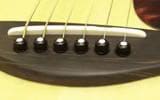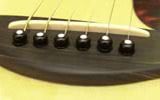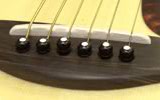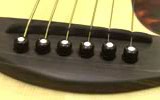-
[Experiment 3] Changing the material of the saddle and nut The Structure of the Acoustic Guitar
The strings on a guitar are supported by the saddle and nut. Although these parts were once made from ivory, they are now made from materials such as animal bones, hardened plastic, or brass. What would happen if we replaced these parts with paper or rubber?
-
Experiment steps
1. Remove the saddle and nut from the guitar.
2. Form pieces of the same shape from wood, multilayer cemented paper, and rubber.
3. Attach to the guitar, adjust the pitch of the strings, and then try playing (in the order listed in step 2.).
Results of the experiment
Standard

Wood

Paper

Rubber

* As this was an experiment, the recorded pitches differed from the correct notes.
The original saddle and nut on the guitar used during the experiment were made from ox bones. Replacing these with wooden parts made the sound slightly muffled and warm. However, wood is much softer than bone, so the steel strings sunk into the parts a bit. When we used hard paper formed by bonding several layers of board paper together, this caused the sound to grow even more muffled, resulting in a pattering timbre that sounded lonely. The strings sunk into the paper nut-especially string 3 which was pulled toward string 2 and misaligned, making playing the instrument difficult. The last step was to use rubber parts. As we tuned the instrument the strings sunk more and more into the rubber, making it impossible to tune. As the strings were drawn down they made contact with the frets on the neck, making it more or less impossible for the instrument to produce sound. This illustrates the need for the saddle and neck to be made from a material that can withstand the tension of the steel strings, and that can transmit sound well.
-
Choosing an Instrument

-
Trivia




